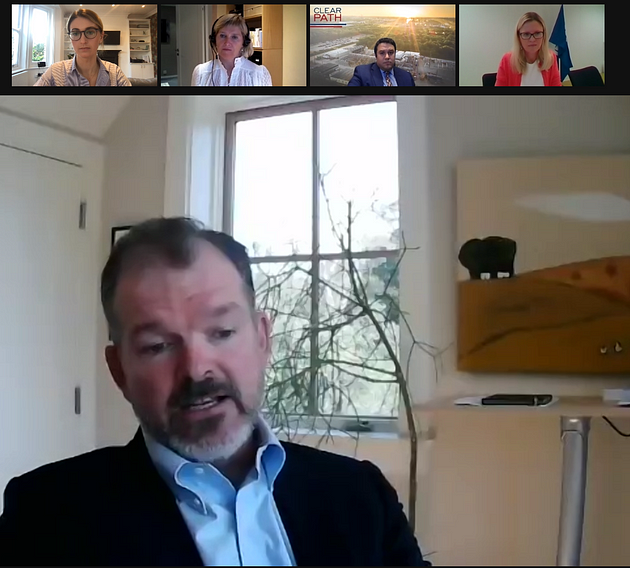
Event overview
Event Overview:
This hour long thought leadership panel explored the role of carbon capture, utilization, and storage technologies (CCUS) in achieving deep decarbonization across the power, transportation, and industrial sectors of the economy as well as the role of CCUS in the development of the global hydrogen market.
Panelists discussed the policy pathways forward for deployment, and opportunities for innovative applications – all while considering how investors, businesses, and policymakers can best work together to accelerate the clean energy transition in light of the new administration.
Recap:
While many thought that COVID would hinder growth in the energy sector, the past year and a half brought rapid transformations — and an increase in CCUS and hydrogen investment, infrastructure, and deployment were no exception. However, despite CCUS and hydrogen technologies expanding over the past year, they are by no means new to the market or as a clean energy and deep decarbonization solution.
Why and how have CCUS and hydrogen suddenly become prominent in the energy sector? What role will these technologies play in the clean energy transition? And what enablers and inhibitors influence their deployment? To help answer some of the most difficult and urgent questions in the green energy world, Dynamo assembled a team of leading industry experts with varying background knowledge and perspectives on CCUS and hydrogen.
The thought leadership discussion began with remarks from event moderator Jeremy Harrell, Managing Director — Policy at ClearPath. Jeremy set the stage by emphasizing the tremendous public and private sector developments that have occurred in the CCUS and hydrogen sphere over the last year.
But despite this past calendar year having the single largest influx of private sector projects and reports forecasting 71 new projects added to the pipeline in 2021, the current pace of deployment doesn’t align with what is required to achieve mid-century climate objectives.
Jeremy then handed the mic over to each of the panelists to discuss how CCUS and hydrogen fit into the deep decarbonization ecosystem.

Samantha McCulloch, Head of Carbon Capture Utilisation and Storage Unit at IEA, began by focusing on the role of CCUS; Samantha commented how while CCUS has its benefits, there are many challenges that still lie ahead — particularly around the rate at which CCUS must scale up. Despite not yet being on track for the level of deployment required to achieve 2050 net zero goals, overcoming this immense challenge is crucial as CCUS plays a vital role in the energy transition.
“Really without CCUS we have few or no solutions for deep decarbonization of heavy industry and particularly cement. CCUS can support a cost-effective scale up low carbon hydrogen, it can be retrofitted to existing energy assets which can, in many cases, be quite young. It also provides a foundation for technology-based approaches for carbon removal.” — Samantha McCulloch, Head of Carbon Capture Utilisation and Storage Unit at IEA
While Samantha provided some granularity around the scale of transformation that’s required, Tom Holmberg, Partner at Baker Botts, focused on the legal aspects. Tom noted that the carbon capture and hydrogen industry is by no means a monolith; the issues and needs addressed by CCUS and hydrogen technologies span across many energy industries and that more commercial and policy progress can still occur in this sector.
Shifting to an investment perspective, the mic was then handed over to Trude Sundset, Strategic Advisor and Business Developer at Aker Horizons. Trude noted how ambitious targets and broad investment portfolios utilize the synergies between companies and the necessary technologies. Trude reminded everyone that business models must be innovative as we begin to commercialize and scale products, such as reducing obstacles for emitters so that they too can be part of the CCS value chain.
The event then moved to a moderated panel discussion which was kicked off by Jeremy asking all three panelists what role carbon capture and hydrogen play in achieving a net zero global economy.
Sam pointed out that we can’t globally achieve net zero while simultaneously delimiting emissions; CCUS’s role in carbon neutrality is to balance remaining emissions in the system, as it’s one of the few solutions some industrial sectors and heavy industry have.
Trude added to Sam’s point by arguing that despite the drawbacks of both CCUS and hydrogen, we no longer have the luxury of debating; the conversation must shift toward solutions. Every tool in the toolbox will have to be used in order to mitigate climate change — and CCUS is a particularly effective tool, especially for hard to abate industries.
The conversation then veered toward the massive and rapid CCUS and hydrogen transformation occurring in the U.S. Tom weighed in on how these developments arose by pointing to a few drivers, all which coalesced around the same time: tax incentives (such as the 45Q tax credit), the Notice of Proposed Rulemaking (which finalized in early 2021), increased momentum around environmental, social, and corporate governance (ESG), as well as a general interest in lower carbon products.
These factors appeared to have done a fantastic job in creating an interest in decarbonization, given that 40 out of the 71 pipeline projects lined up are in North America alone.
Sam pointed to three factors influencing the influx of projects: a renewed attention on CCUS as an addition to the broader clean energy portfolio needed to achieve net zero goals, an improved investment environment, and the increased interest in hydrogen. Sam stated that roughly 40 governments around the world either have an existing or are developing a hydrogen strategy. And since CCUS is a key part of the technological portfolio to produce low carbon hydrogen, an increased interest in hydrogen equals an increased interest in CCUS.
While there are numerous incentives within the US to build CCUS and hydrogen infrastructure, these expansion projects aren’t without obstacles. Tom highlighted two examples of hurdles the industry must overcome. The first being political barriers, including both headwinds the industry faces with the administration and political activists who distrust the role of the oil and gas industry in achieving deep decarbonization. The second being regulatory barriers, such as not having the federal permitting and signing authority like what exists for natural gas pipelines.
Jeremy brought Trude into the conversation to compare the regulatory environment in Norway. Trude boiled down the difference to having brave politicians who were willing to set standards and requirements despite opposition as well as a tradition of cooperation and trust between the government and the industry. Although there are many and differing policy levers and investment environment incentives driving major funding commitments in the US and across Europe, Sam phrased it best when she commented on what the most effective policy leaders are doing to drive development:
“The infrastructure piece is critical. Governments should focus policy support on the development of CO2 transport and storage infrastructure as well mechanisms, like 45Q, that can establish a market for CCUS investments.” — Samantha McCulloch, Head of Carbon Capture Utilisation and Storage Unit at IEA
But transporting and storing carbon is by no means a simple lift, as properly sequestering carbon as well as monitoring and assessing greenhouse gas emissions from the upstream production and transportation of the carbon captured requires accurate measurement.
“At the end of the day what we’re trying to do is to reduce carbon. And if you can’t measure it, you can’t manage it.” — Tom Holmberg, Partner at Baker Botts

The potential liability that comes with storing and monitoring sequestered carbon is undoubtedly a major hurdle the industry must deal with.
Trude commented how Norway is overcoming these barriers by simply creating the infrastructure and building capacity for CO2 storage; given the high up-front costs associated with constructing the physical infrastructure, building the technology and storage capacity incentivizes future projects.
While governments may catalyze the first handful of projects, the private sector must also tap into this unique investment environment. In fact, over the last 18 months the investment community has certainly gained interest, as shown by the vast amounts of private sector capital waiting to be deployed on CCUS and hydrogen projects. Trude expressed the vital need between government and private collaboration best when she said:
“Achieving net zero and implementing successful CCUS and Hydrogen infrastructure projects is such a big challenge. We have to work on this together. If we are to succeed it cannot be competition, it must be a joint effort.” — Trude Sundset, Strategic Advisor and Business Developer at Aker Horizons
The event then transitioned to the audience Q&A portion where the first question focused on blue versus green hydrogen efficacy debate.
Tackling this question is by no means a straight-forward answer — but if there was one thing that all the panelists agreed on it’s that hydrogen’s impact should be measured through a lifecycle assessment of the carbon footprint, not on the color itself. A portfolio of solutions is needed in the hydrogen space in order to achieve net zero 2050 goals.
The next audience question centered around the oil and gas industry’s role in driving down emissions and their transition to becoming carbon management companies. Trude expressed how the energy transition would gain immensely from the skills, technology, and knowledge coming from the oil and gas industry. Sam pointed to engineers and workers’ subsurface expertise, experience building large infrastructure projects, and proficiency in managing the balance sheets needed to invest in the technology.
By the conclusion of the thought leadership discussion, one thing was made abundantly clear: the time to act is now and achieving deep decarbonization necessitates the utilization of all requisite tools in the toolbox. Jeremy summarized key themes prominent throughout the thought leadership discussion when he stated:
“Overall, the CCUS and hydrogen environment is changing: the investment environment, the government financial support and commitment towards driving these technologies, and the private sector’s ambition are all different. As we see the climate math becoming more and more clear, we will see a lot more investment in these technologies moving forward.” — Jeremy Harrell, Managing Director — Policy at ClearPath
While neither CCUS nor hydrogen are the silver bullet solutions to achieving net zero, no solution is. Fortunately, here at Dynamo we’re leading the clean energy transition through incorporating every viable solution into the deep decarbonization equation to ensure we remain on a 1.5C pathway and achieve global emissions targets.
Speakers included:
Samantha McCulloch, Head of Carbon Capture Utilisation and Storage Unit at IEA
 Samantha McCulloch is the Head of the CCUS Unit at the Paris-based International Energy Agency. Her team provides leading analysis and insights on the development and deployment of carbon capture, utilisation and storage technologies. Samantha is a lead author of several IEA publications, including the Energy Technology Perspectives Special Report: CCUS in Clean Energy Transitions. Prior to joining the IEA, Samantha was the Policy Director of the Australian Coal Association and held various positions in the Australian Government. Samantha has a Master of Public Policy, LLB (Hons) and Bachelor of Commerce.
Samantha McCulloch is the Head of the CCUS Unit at the Paris-based International Energy Agency. Her team provides leading analysis and insights on the development and deployment of carbon capture, utilisation and storage technologies. Samantha is a lead author of several IEA publications, including the Energy Technology Perspectives Special Report: CCUS in Clean Energy Transitions. Prior to joining the IEA, Samantha was the Policy Director of the Australian Coal Association and held various positions in the Australian Government. Samantha has a Master of Public Policy, LLB (Hons) and Bachelor of Commerce.
Trude Sundset, Strategic Advisor and Business Development at Aker Horizons
 Trude Sundset is a Strategic Advisor and Business Developer in Aker Horizons, a planet positive investment company. Previously, Sundset was the CEO of Gassnova – the Norwegian state enterprise for CCS. Sundset has broad experience from international organizational work as a board member of organizations such as IEA GHG, CSLF and ZEP as well as leading positions within the area of energy, environment and climate issues in the oil and gas industry.
Trude Sundset is a Strategic Advisor and Business Developer in Aker Horizons, a planet positive investment company. Previously, Sundset was the CEO of Gassnova – the Norwegian state enterprise for CCS. Sundset has broad experience from international organizational work as a board member of organizations such as IEA GHG, CSLF and ZEP as well as leading positions within the area of energy, environment and climate issues in the oil and gas industry.
In Statoil ASA Sundset held positions as: Head of Environment and Climate International and Vice President Environment and Climate Corporate HSE. Trude Sundset has a Master of Science from the Norwegian Institute of Technology (now the Norwegian University of Science and Technology) in Trondheim.
Her broad-based industrial experience and extensive career as a researcher within climate and environmental issues related to the oil and gas sector, have given her an unique insight in green industry development and technological solutions to mitigate climate change.
Tom Holberg, Partner at Baker Botts
 Tom Holmberg is a partner in the Global Projects Group at Baker Botts. He assists clients with energy projects and transactions around the world. He focuses on the development of liquefied natural gas (LNG), hydrogen, CCUS, and natural gas pipeline projects and transactions. He works with clients at all stages of such projects in areas that include project structuring, contracting, governmental approvals, and the negotiation of commercial agreements and project development documents. He is the co-chair of the LNG, hydrogen and CCUS practice groups.
Tom Holmberg is a partner in the Global Projects Group at Baker Botts. He assists clients with energy projects and transactions around the world. He focuses on the development of liquefied natural gas (LNG), hydrogen, CCUS, and natural gas pipeline projects and transactions. He works with clients at all stages of such projects in areas that include project structuring, contracting, governmental approvals, and the negotiation of commercial agreements and project development documents. He is the co-chair of the LNG, hydrogen and CCUS practice groups.
Mr. Holmberg advises clients on an array of regulatory issues, including contract and tariff matters before the Federal Energy Regulatory Commission (FERC). He also represents clients before the Department of Energy (DOE) for authorizations to export and import natural gas under the Natural Gas Act. He has handled administrative and appellate litigation before the FERC and the courts on these matters. He has also represented clients before FERC in electricity market restructuring proceedings.
Jeremy Harrell, Managing Director – Policy at ClearPath
 Jeremy is a Managing Director at ClearPath, where he leads public policy development and promotion efforts. He specializes in clean energy innovation, financing policies, and regulatory reforms that accelerate the development and export of cutting-edge technologies.
Jeremy is a Managing Director at ClearPath, where he leads public policy development and promotion efforts. He specializes in clean energy innovation, financing policies, and regulatory reforms that accelerate the development and export of cutting-edge technologies.
Jeremy is also a member of the U.S. Department of Commerce’s Renewable Energy and Energy Efficiency Advisory Committee (REEAC) and serves in leadership roles at multiple clean energy industry trade groups. He is the Chairman of the U.S. Nuclear Industry Council leads the legislative efforts for Geothermal Rising, the largest association for geothermal energy professionals.
Before joining ClearPath, Jeremy advised Congressional leaders, across multiple roles in the House and Senate, on energy, environmental, national security, tax, and transportation policy for a decade. He received his B.A. in Political Science and History from Miami University in Oxford, Ohio and an M.B.A. from New York University’s Leonard N. Stern School of Business.
Deep Decarbonization: The Role of Carbon Capture and Hydrogen in Achieving a Net-Zero Emissions Economy
Thursday, October 21 2021 - Thursday, October 21 2021
11:00 AM EST
Zoom

Deep Decarbonization: The Role of Carbon Capture and Hydrogen in Achieving a Net-Zero Emissions Economy


